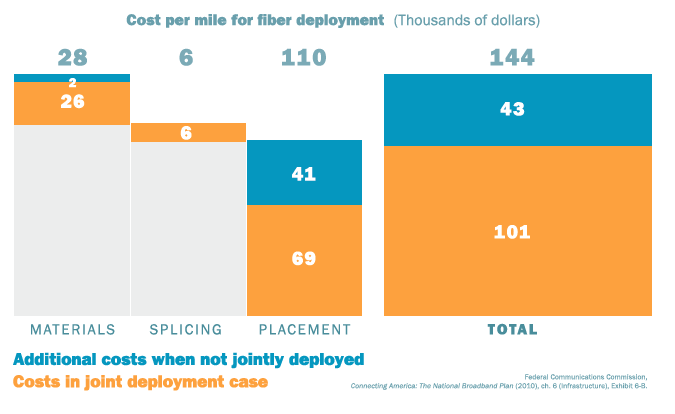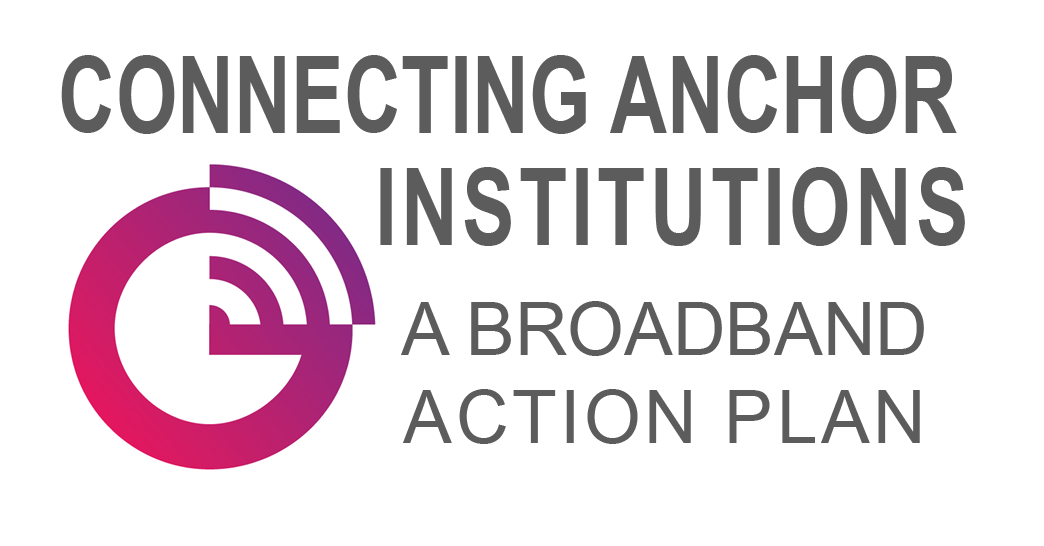Broadband Infrastructure Policy and Community Anchor Institutions
Table of Contents
I. Introduction
II. Dig Once, Rights-of-Way and Conduit Policies
III. Access to Existing Poles and Ducts
IV. Asset Inventories and Databases
V. Wireless Tower Siting Policies
VI. Recommendations
VII. Resources for Further Reading
VIII. Endnotes
IX. Author Bio
Introduction
Federal, state and local government policies concerning access to rights-of-way, pole attachments, tower siting, and other issues can have a significant impact on the pace of broadband network deployment. The National Broadband Plan, the federal Broadband Opportunity Council report, and numerous state and local broadband plans have found that streamlining these decisions can dramatically lower the cost of broadband investment.
For example, the National Broadband Plan found that an effective rights-of-way policy of facilitating joint placement of facilities (known as “dig once” policies) can reduce broadband deployment costs by over 20 percent.

Governments can also lower the cost of broadband deployment by installing empty conduit for fiber optic lines as part of every construction project, including roads, bridges, and sewers. The cost of running a strand of fiber through an empty conduit is 3-4 times less expensive than digging new trenches or attaching fiber to utility poles.[1] Empty conduit can be leased to service providers directly, or the community can use that conduit itself to self-provide fiber and broadband services to community anchor institutions (CAIs) and other governmental purposes.
Streamlining rights-of-way policies and installing empty conduit typically do not require additional funding, but taking these steps does require a concerted effort to change existing bureaucratic practices, ensure equitable access to all broadband competitors, and protect the public interest. Forward-thinking government broadband infrastructure policies improve access to, and use of, existing infrastructure and foster further infrastructure deployment.
Proactive leaders can use the following policy levers to meet the broadband needs of community anchor institutions, promoting infrastructure investments with sufficient scale, breadth, reach, and capacity to serve the economic and social needs of the entire community.
Dig Once, Rights-of-Way and Conduit Policies
In 2013, the Federal Highway Administration estimated that 90 percent of the cost of burying broadband infrastructure along a roadway consists of the expense of digging up and replacing disturbed land and the road.[2] Sharing that expense among multiple uses—by digging once—can lower the cost of fiber deployment considerably, but requires coordination with a variety of broadband providers and government agencies.
Despite the opportunity for considerable cost savings in deployment, dig once policies are not required by the Federal Government or any state government for all infrastructure projects. The major barriers are existing laws. The Federal-Aid Highway Program, for example, can only spend funds on “highway eligible activities;” the U.S. Department of Transportation interprets this to mean that it cannot spend funds coordinating construction projects with broadband infrastructure, absent a specific public interest showing.
In addition, “silo” thinking and policies can stand in the way of dig once opportunities. For example, when the U.S. Environmental Protection Agency (EPA) requires local governments to fix or replace sewer lines as part of a settlement of potential environmental rule violations, the EPA does not generally consider the outlays for joint trenching and broadband conduit to be part of the cost of the project. This policy acts as a disincentive and may effectively limit the ability of cities to adopt a dig once policy for what are frequently major public works investments.[3]
The National Broadband Plan recommended that Congress consider enacting dig once legislation applying to all future federally-funded projects along rights-of-way (including sewers, power transmission facilities, rail, pipelines, bridges, tunnels, and roads).[4] Several bills in Congress have been introduced since 2010 that would establish dig once policies for federal transportation projects and apply standard fees for rights-of-way leases. Some of the ideas under consideration are to:
- Make it the policy of the United States to encourage the deployment of communications facilities.
- Convey a sense of Congress that federal agencies should endeavor to provide for the inclusion of broadband conduits in federally-funded highway construction projects and to do so in a manner that does not negatively impact highway safety or operations and limits burdens on state departments of transportation.
- Establish a common permit application form and fee structure for communications facilities.
- Require highway departments and projects to 1) coordinate with state telecommunications and broadband plans and 2) implement dig once coordination.
- Mandate the installation of broadband conduit—plastic pipes that house fiber-optic communications cable—during the construction of any road receiving federal funding if there is a demonstrated need for broadband in the area within the next 15 years.
In 2012, Executive Order 13616 required the 14 federal agencies that control property to identify and consider adopting dig once “best practices.”[5]
Many cities across the country are adopting conduit installation requirements. The city code in Mt. Vernon, WA, requires the installation of conduit as part of the development of all buildings, homes, subdivisions, streets, and utilities. Mt. Vernon has used this city-owned network of empty conduit to help build an open access telecommunications network that supports community anchor institution connectivity.[6] Brentwood, CA, has a similar policy, requiring developers to install two conduits when doing work in public rights-of-way. One conduit is assigned for city network use. The second is leased to a private provider that will offer Gigabit service to consumers and businesses.[7]
Access to Existing Poles and Ducts
In addition to digging trenches, another way to build broadband networks is by attaching wires and facilities to existing utility poles. There are an estimated 130-180 million utility poles in the U.S. – more than one pole for every household. These poles are generally owned by electric utilities, municipalities, railroads, and traditional telephone companies.
In rural areas, where a provider may need to attach to hundreds of poles to reach a community, even small changes in the cost of attaching to these poles can have a significant impact on broadband deployment. The National Broadband Plan estimated that, in rural areas, pole attachments alone can cost a broadband provider $4.54 to $12.96 per month per subscriber—a significant part of the cost of monthly broadband service.[8]
Governments that own and control these poles and ducts can use them to attract broadband investment. Governments also regulate the rates, terms, and conditions of access to privately-owned poles, which are frequently built on public rights-of-way. Section 224 of the Communications Act gives the Federal Communications Commission (FCC) the power to regulate the rates, terms, and conditions of poles that are owned by private companies. Section 224 also allows states to establish their own pricing rules for privately-owned poles. To date, 19 states and the District of Columbia have established pole attachment policies.
Asset Inventories and Databases
Governments are, by far, the largest owners of property in the nation. Every level of government has the ability to directly affect the cost, nature, and quality of a network build simply by making it easier for private firms to identify and lease space on public buildings, signs, water towers, and other locations. In 2015, the Broadband Opportunity Council recommended that the Federal Government create an “open data inventory of infrastructure assets” for broadband.[9]
Local government can also provide information directly to broadband providers in a way that essentially “markets” those locations to providers. For example, for no upfront cost, Columbus, OH, is working with Connected Nation Exchange[10] to inventory, catalog, and map all civic infrastructure and locations to market to service providers interested in expanding their networks.
Wireless Tower Siting Policies
According to the FCC, the process of deploying wireless towers can be expensive, cumbersome, and time- consuming. In addition to identifying and purchasing or leasing the right location, a provider usually must obtain siting approval from the local municipality and comply with environmental review. The Middle Class Tax Relief and Job Creation Act of 2012 streamlined this process, requiring state and local governments to approve certain wireless broadband facilities’ siting requests and to set timelines for local review of applications.
Recommendations
Dig Once, Rights-of-Way, and Conduit Policies
- Federal, state, and local governments should adopt binding and enforceable “dig once” policies that will lower the cost of broadband deployment by requiring coordination between government and the private sector on broadband construction and upgrades.
- Infrastructure projects and development that involve public rights-of-way, or are built on public lands, or are subsidized with universal service funds, should include installation of empty conduit that can be made available to commercial service providers.
- Federal and state governments should establish common and uniform lease agreements, rates, and terms of access to rights-of-way, public lands and facilities for broadband network construction and upgrades.
- As part of community planning and community anchor institution connectivity initiatives, state and local governments should review rights-of-way management policies, including fees charged, in order to streamline approval and lower the costs of that connectivity. Community anchor institution representatives should be included in this assessment and review.
- In negotiating rights-of-way arrangements with broadband service providers, local policymakers should ensure that community anchor institutions are offered service at appropriate and affordable rates, terms, and conditions.
- In using or leasing empty fiber optic conduit, government should ensure that community anchor institutions have the ability to lease or obtain dark or lit fiber services through that conduit.
Effective Pole Attachment Management and Regulation
- Federal, state and local authorities responsible for resolving pole attachment disputes between providers and utilities should do so quickly, effectively, and in a pro-competitive manner.
- Policymakers should revise pole attachment rules so that they: (a) include all utility poles, ducts, and conduit; (b) provide clear, consistent, uniform, and low rental and make-ready rates for attachments for all broadband, cable, and telecommunications providers; (c) establish clear timelines and terms of access; and (d) include enforceable commitments.
Asset and Property Management
- The Federal Government[11] should implement the federal asset inventory database recommended by the Broadband Opportunity Council (BOC).
- State and local governments should implement similar asset inventory databases and should, as recommended by the BOC, work with federal authorities to develop a common platform for those databases.
- Community anchor institution sites and facilities should be included in all community asset inventory databases.
Wireless Tower Siting Policies
- State and local governments should move quickly to fully implement Section 6409(a) of the Middle Class Tax Relief and Job Creation Act of 2012, which expedites wireless tower siting policies.
Resources for Further Reading
- U.S. Department of Agriculture and U.S. Department of Commerce, Broadband Opportunity Council Report and Recommendations, August 20, 2015. To make sure that the Federal government does everything within its power to support broadband deployment and adoption, President Barack Obama created the Broadband Opportunity Council and tasked it to produce specific recommendations to increase broadband deployment, competition and adoption through executive actions within the scope of existing agency programs, missions and budgets. https://www.whitehouse.gov/sites/default/files/broadband_opportunity_council_report_final.pdf
- Broadband Deployment on Federal Property Working Group, Implementing Executive Order 13616: Progress on Accelerating Broadband Infrastructure Deployment, August 2013. President Obama issued an Executive Order to facilitate wired and wireless broadband infrastructure deployment on Federal lands, buildings, and rights-of-way, federally assisted highways, and tribal and individual Indian trust lands, particularly in underserved communities. The E.O. established and charged the Broadband Deployment on Federal Property Working Group with ensuring a coordinated approach in implementing agency procedures, requirements, and policies related to these topics. https://www.whitehouse.gov/sites/default/files/microsites/ostp/broadband_eo_implementation.pdf
- CTC Technology & Energy, Gigabit Communities: Technical Strategies for Facilitating Public or Private Broadband Construction in Your Community, 2014. The key ingredient for private investment in gigabit deployment is true partnership. It is not enough for the locality to undertake all these steps if there is no willing and able private partner—one that is committed to building next-generation infrastructure rather than simply reducing costs on existing legacy networks. http://www.ctcnet.us/wp-content/uploads/2014/01/GigabitCommunities.pdf
- Federal Communications Commission, Connecting America: The National Broadband Plan, Chapter 6 (Infrastructure), March 2010. The plan recommended that 1) government should take steps to improve utilization of existing infrastructure to ensure that network providers have easier access to poles, conduits, ducts and rights-of-way and 2) the federal government should foster further infrastructure deployment by facilitating the placement of communications infrastructure on federally managed property and enacting dig once legislation. https://transition.fcc.gov/national-broadband-plan/national-broadband-plan.pdf
- Federal Highway Administration, U.S. Department of Transportation, Successful Practices of Broadband Deployment in Highway Rights- of-Way: Summary Paper, May 2013. This paper presents an overview of successful broadband deployment practices in highway rights-of-way, with a focus on the installation of underground fiber optic facilities and related efforts to minimize excavation of the roadway. https://www.fhwa.dot.gov/policy/otps/successprac.pdf
- Office of Transportation Policy Studies, Federal Highway Administration, U.S. Department of Transportation, Policy Brief: Minimizing Excavation through Coordination, October 2013. What is dig once and what are the policy implications? https://www.fhwa.dot.gov/policy/ otps/policy_brief_dig_once.pdf
- Tim Feran, “Map could help Columbus ramp up Broadband,” Columbus Dispatch, March 29, 2015. Connected Nation Exchange will develop a map for the city that shows where Columbus, OH, owns properties that can be used to expand broadband networks. Those properties include buildings, rooftops, towers, utility poles, signs, water tanks and existing fiber-optic lines. http://www.dispatch.com/content/stories/business/2015/03/29/1-map-could-help-city-ramp-up-broadband.html
- Christopher Mitchell, “Mesa’s Focus on Dig Once and Fiber Leases Pays Off,” Community Broadband Networks, February 24, 2015. Mesa, AZ, is one of the largest communities in the nation to benefit from the city taking a role in ensuring conduit and fiber are available throughout the area. https://muninetworks.org/content/mesas-focus-dig-once-and-fiber-leases-pays-community-broadband-bits-podcast-139
- Connect Every Acre, Iowa House File 655, June 22, 2015. Legislation aimed at better coordinating of broadband access in targeted areas of the state. https://www.legis.iowa.gov/legislation/BillBook?ga=86&ba=HF655
- National Association of Counties, National League of Cities, and National Association of Telecommunications Officers and Advisors, Wireless Facility Siting: Model Chapter Implementing Section 6409(a), March 5, 2015. A guide to help: 1) develop a model ordinance and application for reviewing eligible facilities requests under Section 6409(a); 2) distribute wireless siting best practices; 3) create a checklist that local government officials can use to help streamline the review process; and 4) hold webinars regarding the application process. http://www.naco.org/sites/default/files/Model-Ord-NACo.pdf
- Levin, Blair and Denise Linn. The Next Generation Network Connectivity Handbook: A Guide for Community Leaders Seeking Affordable, Abundant Bandwidth Benton Foundation, July 2015. A comprehensive guide for communities who want better broadband for their residents and businesses based on the experience of 25 Gig.U communities. http://www.gig-u.org/cms/assets/uploads/2015/07/Val-NexGen_design_7.9_v2.pdf
- Google Fiber City Checklist, February 2014. A collection of best practices recommended by the Fiber to the Home Council, Gig.U and the U.S. Conference of Mayors that can help any fiber provider or city that is thinking of building a new network. https://fiber.storage.googleapis.com/legal/googlefibercitychecklist2-24-14.pdf
Endnotes
- CTC Technology & Energy, A Model for Understanding the Cost to Connect Schools and Libraries with Fiber Optics (October 2014), http://www.ctcnet.us/wp-content/uploads/2014/10/Connecting-Schools-and-Libraries-20141017.pdf (estimating per-mile cost of deploying fiber through existing conduit to be $15,000-27,000, compared to cost of new aerial construction of $51,000 per mile and the new underground construction starting at $64,000 per mile).
- Office of Transportation Policy Studies, Federal Highway Administration, U.S. Department of Transportation, Policy Brief: Minimizing Excavation through Coordination (Oct. 2013), https://www.fhwa.dot.gov/policy/otps/policy_brief_dig_once.pdf, at 1.
- Staci Pies, Comments of Google, Inc re: Broadband Opportunity Council Notice and Request for Comment, (June 10, 2015): 5-6 https://www.ntia.doc.gov/files/ntia/google_inc_boc.pdf
- Federal Communications Commission. Connecting America: The National Broadband Plan. (Washington, DC, March 17, 2010.) https://www.fcc.gov/general/national-broadband-plan http://www.broadband.gov/plan/6-infrastructure/#s6-2
- Executive Order No. 13616, Accelerating Broadband Infrastructure Deployment (June 14, 2014), https://www.gpo.gov/fdsys/pkg/FR-2012-06-20/pdf/2012-15183.pdf. Broadband Deployment on Federal Property Working Group, Implementing Executive Order 13616: Progress on Accelerating Broadband Infrastructure Deployment (Aug. 2013), https://www.whitehouse.gov/sites/default/files/microsites/ostp/broadband_eo_implementation.pdf at 8-10
- Institute for Local Self-Reliance, “Smart Conduit Policy in Sandy, Mount Vernon Reduces Network Cost,” (June 14, 2013), http://muninetworks.org/content/smart-conduit-policy-sandy-mount-vernon-reduces-network-cost (quoting Mount Vernon, WA municipal code).
- Nate Gartrell, “Sonic partners with Brentwood to bring high-speed Internet to Town,” San Jose Mercury News (May 20, 2015), http://www.mercurynews.com/my-town/ci_28155550/sonic-partners-brentwood-bring-high-speed-internet-town; see also Brentwood (CA) Municipal Code, Section 16,120.120(C) http://qcode.us/codes/brentwood/view.php?topic=16-16_120-16_120_120
- Connecting America; The National Broadband Plan, ch. 6 at 110.
- US Departments of Commerce and US Department of Agriculture, Broadband Opportunity Council Report and Recommendations, (August 20, 2015) https://www.ntia.doc.gov/files/ntia/publications/broadband_opportunity_council_report_final.pdf
- Connected Nation Exchange (CNX) is a spin-off of Connected Nation and aims to serve as a trusted intermediary between cities who manage public assets and the wireless carriers who seek access to properties that can help densify their networks.
- Here this term refers specifically to the National Economic Council (NEC), the White House Office of Science and Technology Policy (OSTP) and the Office of Management and Budget (OMB) working with the Departments of Agriculture, Commerce, Energy, Interior and Transportation as well as the General Services Administration.
About the Author
Tom Koutsky serves as Chief Policy Counsel for Connected Nation. Tom provides vision and leadership for Connected Nation’s research and policy initiatives. Tom joined Connected Nation from the Federal Communications Commission where he served as a Senior Advisor to the team that wrote the first U.S. National Broadband Plan. Tom focused on policy recommendations related to network infrastructure, the law and economics of middle-mile connectivity, wholesale competition rules, and universal service and access charge reform.
Policy Papers
Latest Updates From Twitter
Action Plan Authors
Amelia Bryne
Kelleigh Cole
Joanne Hovis
Tom Koutsky
Blair Levin
Christine Mullins
Angela Siefer
Gina Spade
John Windhausen
Steering Committee
Larra Clark, American Library Association
Adrianne Furniss, Benton Foundation
Kevin Taglang, Benton Foundation
Bob Collie, ENA
Lil Kellogg, ENA
Rex Miller, ENA
Susannah Spellman, Internet2/USUCAN









 Download Full Action Plan
Download Full Action Plan